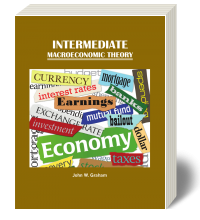

Intermediate Macroeconomic Theory
First Edition Graham, © 2015
This textbook is suitable for a macroeconomic analysis course.
Request Examination CopyPrices and ISBNs
This title is available in the following formats.
|
Product
Description ISBN |
Description | ISBN | Bookstore (Net Price) |
Student (Retail Price) |
Description
Intermediate Macroeconomic Theory is a 15-chapter textbook intended for upper-level undergraduate students and masters students who want a rigorous graphical and algebraic treatment of standard neoclassical macroeconomics.
After an introductory chapter focused on the measurement of economic aggregates, chapters 2-8 carefully develop the IS-LM-aggregate-demand-supply model of the economy in the short run and its determination of real output, interest rates, the price level, wages and employment. The IS-LM model is introduced using both basic algebra and multiple graphs. Unlike some textbooks, an entire chapter is devoted to alternative perspectives on aggregate supply, fully derived from the aggregate production function and labor market. The complete IS-LM-AD-AS model is used to analyze the impact of demand and supply shocks and alternative policy responses. A separate chapter is devoted to comparing the relative effectiveness of monetary and fiscal policies, the zero-lower-bound problem and monetary targets.
Chapters 9-11 modify the short-run model to distinguish between nominal and real interest rates and to focus on the relationship between inflation and unemployment. Short and long run Phillips curves are developed as a natural extension of aggregate supply. Also discussed are costs and benefits of inflation, types of unemployment, and the conduct of economic policy under uncertainty (via fixed policy rules versus discretion).
The next two chapters develop the neoclassical growth model, with an emphasis on the Solow model with and without technological change. There is also a discussion of the optimal saving rate and endogenous growth models. The final two chapters are devoted to contemporary fiscal and monetary policy issues. Alternative theories of consumption and saving are introduced to examine the effect of tax policies and budget deficits. Monetary policy issues include the use of the Taylor rule for setting short-term interest rates, quantitative easing, the Fed's balance sheet and the use of forward guidance.
Examination copies of this book are only available in digital format.
Please email us to request access.